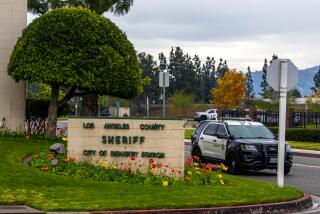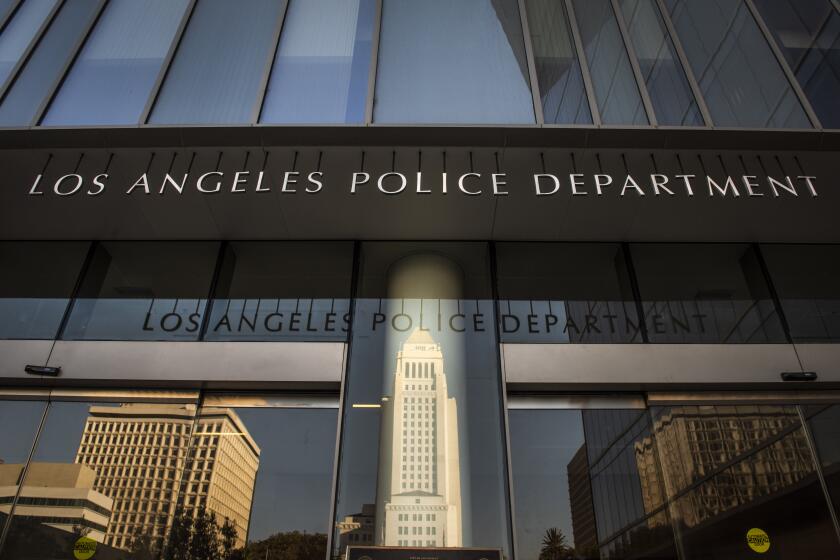Gang Report Scorned as Unjust Stereotyping : Reaction: Community leaders and youths who feel maligned say the data reflects police prejudice.
At 17, Anthony Hayes has had his fill of gang life. After 11 months at a juvenile detention camp for armed robbery, he no longer uses his gang nickname and is going straight.
He is studying hard at school, has a job at Home Depot and is aiming for college. But in a police computer system, he is still considered a gang member.
“I’m trying to overcome all the negatives in my life, but it could all come back on me because of what I was before,” Hayes said Thursday.
His classmates--many of them black youths from neighborhoods rife with gang activity--share his frustration.
From the housing projects of Watts to the middle-class Crenshaw district, residents of South Los Angeles--including community activists, gang workers and clergymen--reacted with outrage Thursday to law enforcement statistics that list almost half of the black men in the county in their early 20s as gang members.
They characterized that contention--part of a report released Thursday by Dist. Atty. Ira Reiner--as the ultimate unjust stereotyping of black males. It is based, they argued, on racial fears, a misunderstanding of certain clothing styles, and the whims of police officers who consider anyone in certain neighborhoods to be part of a gang.
“For the leading justice figures in our city to so loosely define and irresponsibly label members of our community is unacceptable,” said the Rev. Edgar E. Boyd, pastor of Bethel African Methodist Epsicopal Church.
Law enforcement officials say the names in their gang database are culled from arrest reports, police interviews, probation reports and so-called “field inquiry cards” filled out by police officers and sheriff’s deputies who stop and question youths, even if no arrest is made.
“I just can’t believe those numbers are true,” said Kerman Maddox, a community activist and former aide to Mayor Tom Bradley. “I would certainly question what empirical data they used to reach that conclusion.”
He and others said they based their criticism of the police data on their own experiences and those of others, who say police routinely harass young black men and presume that they are gang members.
Some also took issue with the study’s contention that there are 150,000 gang members and 1,000 gangs in Los Angeles County.
A veteran Los Angeles County probation officer, who spoke on the condition his name not be made public, said he recently was going through a gang database and saw that the same gang was listed twice, once under its English name and again in Spanish.
“I challenge them to count every one of these 150,000 so-called gang members,” said the probation officer. “My assessment is that maybe a quarter of them are what I consider hard-core, bona fide gang members. The rest are just hangers or wanna-bes.”
The figures, he said, “help fuel racial prejudice and bigotry that we are already living under.”
In Watts, several black men complained of being stopped by police so often that they no longer keep count. Without exception, they said, officers first ask them what gang they belong to.
“If you are not a criminal, they make you feel like one,” said Mark Hill, 26, a resident of the Imperial Courts housing project who works in a J.C. Penney warehouse and has never been in a gang. “They pull up your shirt sleeves looking for tattoos. They make you want to go out and get a tattoo.”
Hill and two friends--neither of them a gang member--said they have watched police officers list gang affiliations next to their names while they were being questioned. Hill estimated he had been stopped by police and questioned more than 100 times since adolescence without ever being arrested.
When he tells officers he is not in a gang, he said, they act incredulous.
“What constitutes a gang member?” said George Bogard, who has tattoos on his face and neck and considers himself an inactive member of a street gang. “By their criteria, you might as well consider every black man that wears a Raiders (cap) and Nikes” shoes a gang member, he said.
Others said police harass and label as gang members any young black men who wear beltless pants low on their hips, shirts with the names of certain sports teams and baggy jackets, even though there is little distinction between the clothing worn by gang members and the styles popular among all young people.
“It’s hard to tell. Unless you are wearing a rayon suit, police think you are a gang member,” said Nikki Jackson, 16, a student at an alternative high school run by the Community Youth Sports and Arts Foundation, an anti-gang agency in the Crenshaw district.
“People out here can’t afford to go to the Beverly Center and buy other clothes all the time,” she said.
Many of Jackson’s 25 classmates said the police statistics reflect negative law enforcement attitudes about black youths. “They stereotype us all, label us as thugs, hoodlums when they see a group of us,” Jackson said.
The release of the gang report at a time when the two major black gangs--the Crips and Bloods--have declared a truce between them, is “a blatant slap in the face” to that effort, said Boyd, whose church has been working with gang members who want to reform.
Chilton Alphonse, director of the alternative school, said he agrees with at least one issue raised by the report--the need for more educational and job opportunities for youths attempting to escape gangs.
“The system has created these problems and is now targeting these youths as the enemy,” Alphonse said. “It seems like they are on America’s hit list. And instead of correcting the problem, we are trying to go in and arrest them all.”
More to Read
Start your day right
Sign up for Essential California for news, features and recommendations from the L.A. Times and beyond in your inbox six days a week.
You may occasionally receive promotional content from the Los Angeles Times.





